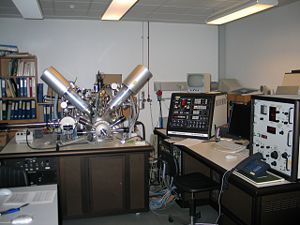Specific Process Knowledge/Characterization/SIMS: Secondary Ion Mass Spectrometry: Difference between revisions
Appearance
No edit summary |
No edit summary |
||
| Line 3: | Line 3: | ||
==Atomika SIMS== | ==Atomika SIMS== | ||
[[Image:Equipment_SIMS.jpg|300x300px|thumb|Atomika SIMS: positioned in the basement of building 346 (underneath the cleanroom).]] | [[Image:Equipment_SIMS.jpg|300x300px|thumb|Atomika SIMS: positioned in the basement of building 346 (underneath the cleanroom).]] | ||
[http://labmanager.danchip.dtu.dk/function.php?module=Machine&view=view&page_id=169 The Atomika SIMS in Labmanager] | |||
The Atomika SIMS analyses the composition of a sample by secondary ion mass spectroscopy. By using either oxygen or cesium ions accelerated by a high tension the surface of the sample is sputtered off as ions. These ions are analysed in a mass spectrometer and one can determine the elemental composition as a function of depth. If compared to signals from reference materials one can quantify the atomic composition - in certain cases down to extremely low concentrations (ppm). Doping levels and impurities may be determined. | |||
Please note that no user will be instructed on the SIMS. Danchip staff will run your samples. | |||
==An overview of the performance of the SIMS== | |||
==An overview of the performance of the | |||
{| border="2" cellspacing="0" cellpadding="10" | {| border="2" cellspacing="0" cellpadding="10" | ||
|- | |- | ||
!style="background:silver; color:black;" align="left"|Purpose | !style="background:silver; color:black;" align="left"|Purpose | ||
|style="background:LightGrey; color:black"| | |style="background:LightGrey; color:black"| Determination of atomic composition | ||
* | |style="background:WhiteSmoke; color:black"| | ||
* | * Doping level | ||
* Sample contamination | |||
|- | |- | ||
!style="background:silver; color:black" align="left"|Performance | !style="background:silver; color:black" align="left"|Performance | ||
|style="background:LightGrey; color:black"|Measurement accuracy | |style="background:LightGrey; color:black"|Measurement accuracy depends on | ||
|style="background:WhiteSmoke; color:black"| | |style="background:WhiteSmoke; color:black"| | ||
* | * Which atoms to be analysed | ||
* The sample morphology (flat samples are much more suited than particles) | |||
|- | |- | ||
!style="background:silver; color:black" align="left"|Process parameters | !style="background:silver; color:black" align="left"|Process parameters | ||
|style="background:LightGrey; color:black"| | |style="background:LightGrey; color:black"| | ||
|style="background:WhiteSmoke; color:black"| | |style="background:WhiteSmoke; color:black"| | ||
*Syringe 1: Water (H2O) | *Syringe 1: Water (H2O) | ||
| Line 45: | Line 37: | ||
*Manual dispense is also possible | *Manual dispense is also possible | ||
|- | |- | ||
!style="background:silver; color:black" align="left"|Sample requirements | !style="background:silver; color:black" align="left" rowspan="3" |Sample requirements | ||
|style="background:LightGrey; color:black"|Substrate material allowed | |style="background:LightGrey; color:black"|Substrate material allowed | ||
|style="background:WhiteSmoke; color:black"| | |style="background:WhiteSmoke; color:black"| | ||
*In principle all materials | *In principle all materials | ||
|- | |- | ||
|style="background:LightGrey; color:black"|Substrate size | |style="background:LightGrey; color:black"|Substrate size | ||
|style="background:WhiteSmoke; color:black"| | |style="background:WhiteSmoke; color:black"| | ||
* | * The samples must be cut into 5x5 or 7x7 mm pieces | ||
* Other types of samples must be mounted onto appropriately sized carriers | |||
|- | |- | ||
|style="background:LightGrey; color:black"|Batch size | |style="background:LightGrey; color:black"|Batch size | ||
|style="background:WhiteSmoke; color:black"| | |style="background:WhiteSmoke; color:black"| | ||
* | * The sample holder carries up to 6 samples at the time | ||
|- | |- | ||
|} | |} | ||
Revision as of 13:29, 24 January 2014
Feedback to this page: click here
Atomika SIMS

The Atomika SIMS in Labmanager
The Atomika SIMS analyses the composition of a sample by secondary ion mass spectroscopy. By using either oxygen or cesium ions accelerated by a high tension the surface of the sample is sputtered off as ions. These ions are analysed in a mass spectrometer and one can determine the elemental composition as a function of depth. If compared to signals from reference materials one can quantify the atomic composition - in certain cases down to extremely low concentrations (ppm). Doping levels and impurities may be determined.
Please note that no user will be instructed on the SIMS. Danchip staff will run your samples.
An overview of the performance of the SIMS
| Purpose | Determination of atomic composition |
|
|---|---|---|
| Performance | Measurement accuracy depends on |
|
| Process parameters |
| |
| Sample requirements | Substrate material allowed |
|
| Substrate size |
| |
| Batch size |
|
